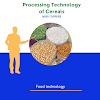CORN: CLASSIFICATION, DRY MILLING AND WET MILLING
INTRODUCTION
Corn or Maize (Zea mays, L) is used for animal feeding, for human consumption and for the manufacture of starch, corn syrup solids, sugar, beer, industrial spirit, etc. The products of milling include maize grits, meal, flour, and protein and corn steep liquor. Corn is consumed as human food in many forms. In its harvested wet form, it is consumed as vegetable. The ready-to-eat breakfast cereal ‘corn flakes’ is made form maize grits. Popcorn – the first snack food is undoubtedly the oldest snack food. The majority of corn consumed as human food has undergone milling and is consumed as a specific or modified fraction of the original cereal grain.
Like other cereal grains, corn is milled to remove hulls and germ.
CLASSIFICATION
Maize or corn is classified commercially into four main classes as follows:
1. Dent varieties, which, when mature have a pronounced depression or dent at the top of the kernel. These have hard patches of densely packed endosperm cells at the outer edges of their endosperm and soft, opaque cells toward their center. Their shapes vary from long and narrow to wide and shallow.
2. Flint varieties, which have a continuous hard layer surrounding the endosperm. When these kernels dry, they dry evenly and therefore do not form a dent.
3. Flour or soft varieties, which are almost entirely opaque and soft. It is the soft maize varieties that are normally used to make corn flour.
4. Waxy maize varieties that have a waxy appearance especially when broken.
The starch consists of very little amylose and is effectively 100% amylopectin (maize starch is normally about 30% amylose and 70% amylopectin).
CORN PROCESSING
Maize is processed by dry or wet milling. Dry milling may or may not include de-germing as a preliminary step. Non-de-germing dry milling is carried out on a local basis in small grist mills or in modern roller mills using sifters and purifiers. The maize is ground to make coarse wholemeal of 85 – 95% extraction rate. This wholemeal is highly susceptible to the rancidity as the germ is retained which has a high oil content. Wet milling and dry milling involving de-germing are carried out in large commercial mills.
DRY MILLING
Two different systems are used for dry milling of corn.
The non-degerming system grinds corn into mill with hardly any separation of germ. This corn meal has comparatively shorter shelf-life, as the germ is retained, which contains 32– 35% oil. This oil in presence of oxygen and lipolytic enzymes is prone to oxidative and hydrolytic rancidity.
Hence, it is necessary to remove the germ from corn to produce corn products with much lower fat content and greater shelf-life.
Tempering and degerming system remove most of the germ and hull and leave the endosperm as free of oil and fibre as possible to recover maximum yield of endosperm and germ as large clean particles.
Corn is cleaned to remove dirt, stones, insects, tramp iron, broken kernels and extraneous plant materials.
The corn is then conditioned by adding water to increase the moisture content to 20%, and the moistened corn is allowed to equilibrate for 1 – 3 hrs. The objective of conditioning is to loosen the germ and toughen the bran and to mellow the endosperm so as to obtain a maximum yield of grits and a minimum yield of flour in the subsequent milling.
Degerming and dehulling is carried out in one of the three ways:
1. Beall de-germinator (De-germer and corn huller)
2. With roller mills and sifters
3. With impact machines such as entoleters and gravity separators.
Once the germ and hull are removed, the endosperm is reduced in size to grits with roller mills. A complex array of additional roller mills and particle size separating equipment is used to purify and size endosperm particles. All products must be dried prior to packaging or bulk storage.
WET MILLING
Wet milling of corn is achieved by a combination of chemical and mechanical means. Wet milling begins with steeping of cleaned corn for 30 – 48 hours with water. Sulphur dioxide is added to the water at the rate of 0.1 – 0.2% and the solution is heated to about 50°C. This condition prevents growth of putrefying microorganisms.
During steeping, the kernel absorb solution and swell, activating enzymes native to the kernel to assist in breaking down the structure; the bisulphiteion reduces disulphide bonds in the protein matrix, increasing protein solubility and diminishing interactions between starch and protein; the lactic acid and/or exogenous enzymes produced by the lactobacilli help soften the endosperm.
After steeping corn is ready for grinding and fractionating in disc attrition mill. The ground slurry is then pumped to hydro clones (liquid cyclones) to separate lighter-weight germs. The germs are dried and processed for oil and meal. The heavier underflow from the hydro clones is screened, and larger particles are finely reground with an impact mill to free the starch, protein, and fibre from each other.
Fibre is separated and washed over series of screens.
The remaining stream of starch and protein is passed through disc nozzle type centrifuges, where heavier starch is separated from the gluten.
The gluten is dewatered using additional centrifuges and vacuum filters. The remaining starch slurry is washed and passed through hydro clones. Centrifuges and/or vacuum filter dewater the purified starch.















0 Comments
Send feedback